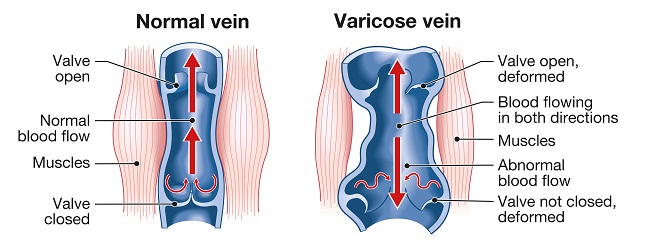As varicose veins can progress to cause unpleasant symptoms and serious medical conditions like venous ulcers, it’s important to know when you should seek treatment. So, here are the 6 stages of varicose veins to help you spot the warning signs.
1. CVI
The first stage of this venous disorder is Chronic Venous Insufficiency or CVI. The catalyst of varicose veins, CVI involves the little valves in your veins not closing properly. As these valves stop your blood from flowing backwards on its journey to the heart, the malfunction causes the blood to pool in your extremities (a condition known as venous reflux).
Blood flow around the area slows, slowing oxygen and nutrient delivery and expanding the vein walls. And as a result, you may start experiencing heaviness and cramping in your limb. You may also notice red spots, an odd sheen to your skin, and occasional swelling after long periods of sitting or standing.
To circumvent varicose veins entirely, it’s best to seek treatment at this stage of the disorder. Even without visible varicose veins, we’ll be able to spot faulty valves through a venous ultrasound and take the necessary steps to address the issue.
2. Enlarged Veins

Illustration showing varicose veins and normal veins
As blood keeps pooling and stretching the vein, it will grow into a varicose vein; a large, twisted, dark blue vessel that will protrude above the skin’s surface. You may also see some spider veins popping up near the varicose one. Understandably, many patients seek treatment at this stage to get rid of their unsightly veins.
Learn more: Varicose Veins, Spider Veins, Feeder Veins
3. Increased Discomfort
Sometimes, patients don’t experience any discomfort at the enlarged veins stage. But for many, the condition may worsen over time. The accompanying symptoms usually include burning sensations, itchiness, and aches during the day that progress into pain at night. Generally, you’ll be able to ease some of the discomfort through compression socks, elevation, and anti-inflammatory medication. But again, treatment is the only reliable, long-term solution to these symptoms.
4. Oedema
As we mentioned, CVI may cause swelling, especially in the legs after long hours of standing or sitting. But if the varicose veins are left unaddressed, they may lead to oedema. Oedema is essentially chronic swelling resulting from overflowing veins and fluid build-up in the tissues surrounding the varicose vein.
5. Skin Changes
With slowed oxygen and nutrient delivery, your skin won’t get what it needs to stay strong and healthy. So, along with a sheen, you may start noticing redness and inflammation, discolouration (known as hyperpigmentation), and a tough, leathery texture that makes it prone to breakage and infection.
Learn more: How Varicose Veins Affect the Skin
6. Ulceration
A venous ulcer is one of the final stages of varicose veins. It’s an open sore that’s extremely slow to heal, difficult to treat, and has a very high recurrence rate.
Learn more: How Do Venous Ulcers Form
We know that sounded scary
Fortunately, you may be able to slow the progression of varicose vein stages through certain lifestyle changes. And, of course, modern technology means you won’t have to get vascular surgery to treat the condition. We offer safe, effective, and minimally invasive varicose vein treatments.
So, whether you’re at stage one or six, come and see us for a consultation. Call us on 0420 102 637 or book online now.

